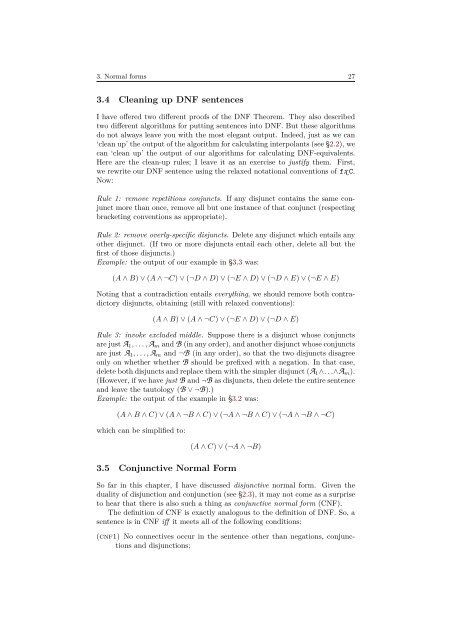Metatheory - University of Cambridge
Metatheory - University of Cambridge
Metatheory - University of Cambridge
You also want an ePaper? Increase the reach of your titles
YUMPU automatically turns print PDFs into web optimized ePapers that Google loves.
3. Normal forms 27<br />
3.4 Cleaning up DNF sentences<br />
I have <strong>of</strong>fered two different pro<strong>of</strong>s <strong>of</strong> the DNF Theorem. They also described<br />
two different algorithms for putting sentences into DNF. But these algorithms<br />
do not always leave you with the most elegant output. Indeed, just as we can<br />
‘clean up’ the output <strong>of</strong> the algorithm for calculating interpolants (see §2.2), we<br />
can ‘clean up’ the output <strong>of</strong> our algorithms for calculating DNF-equivalents.<br />
Here are the clean-up rules; I leave it as an exercise to justify them. First,<br />
we rewrite our DNF sentence using the relaxed notational conventions <strong>of</strong> fx C.<br />
Now:<br />
Rule 1: remove repetitious conjuncts. If any disjunct contains the same conjunct<br />
more than once, remove all but one instance <strong>of</strong> that conjunct (respecting<br />
bracketing conventions as appropriate).<br />
Rule 2: remove overly-specific disjuncts. Delete any disjunct which entails any<br />
other disjunct. (If two or more disjuncts entail each other, delete all but the<br />
first <strong>of</strong> those disjuncts.)<br />
Example: the output <strong>of</strong> our example in §3.3 was:<br />
(A ∧ B) ∨ (A ∧ ¬C) ∨ (¬D ∧ D) ∨ (¬E ∧ D) ∨ (¬D ∧ E) ∨ (¬E ∧ E)<br />
Noting that a contradiction entails everything, we should remove both contradictory<br />
disjuncts, obtaining (still with relaxed conventions):<br />
(A ∧ B) ∨ (A ∧ ¬C) ∨ (¬E ∧ D) ∨ (¬D ∧ E)<br />
Rule 3: invoke excluded middle. Suppose there is a disjunct whose conjuncts<br />
are just A 1 , . . . , A m and B (in any order), and another disjunct whose conjuncts<br />
are just A 1 , . . . , A m and ¬B (in any order), so that the two disjuncts disagree<br />
only on whether whether B should be prefixed with a negation. In that case,<br />
delete both disjuncts and replace them with the simpler disjunct (A 1 ∧. . .∧A m ).<br />
(However, if we have just B and ¬B as disjuncts, then delete the entire sentence<br />
and leave the tautology (B ∨ ¬B).)<br />
Example: the output <strong>of</strong> the example in §3.2 was:<br />
(A ∧ B ∧ C) ∨ (A ∧ ¬B ∧ C) ∨ (¬A ∧ ¬B ∧ C) ∨ (¬A ∧ ¬B ∧ ¬C)<br />
which can be simplified to:<br />
(A ∧ C) ∨ (¬A ∧ ¬B)<br />
3.5 Conjunctive Normal Form<br />
So far in this chapter, I have discussed disjunctive normal form. Given the<br />
duality <strong>of</strong> disjunction and conjunction (see §2.3), it may not come as a surprise<br />
to hear that there is also such a thing as conjunctive normal form (CNF).<br />
The definition <strong>of</strong> CNF is exactly analogous to the definition <strong>of</strong> DNF. So, a<br />
sentence is in CNF iff it meets all <strong>of</strong> the following conditions:<br />
(cnf1) No connectives occur in the sentence other than negations, conjunctions<br />
and disjunctions;
















